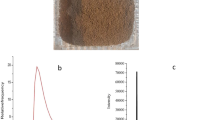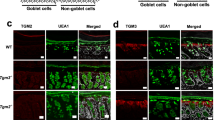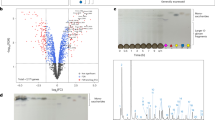Abstract
THE red alga Dilsea edulis (natural order, Cryptonemiales; family, Dumontiaceæ) has recently been shown to yield a mucilage which consists of a galactan sulphuric ester containing two SO3H groups and one uronic acid lactone residue associated with nine galactose residues. The linkages of the galactose residues are predominantly 1 : 3; but about one in every five is linked 1 : 41,2.
This is a preview of subscription content, access via your institution
Access options
Subscribe to this journal
Receive 51 print issues and online access
$199.00 per year
only $3.90 per issue
Buy this article
- Purchase on SpringerLink
- Instant access to full article PDF
Prices may be subject to local taxes which are calculated during checkout
Similar content being viewed by others
References
Barry and Dillon, Proc. Roy. Irish Acad., B, 50, 349 (1945).
Dillon and McKenna, Proc. Roy. Irish Acad. (in the press).
Levring, Lunds Universitets Arsskrift, 33, 8, 98 (1937).
Kylin, Z. physiol. Chem., 83, 195 (1913).
Haas and Russell-Wells, Biochem. J., 23, 425 (1929).
Hassid, J. Amer. Chem. Soc., 55, 4163 (1935); 57, 2046 (1937).
Percival, Nature, 154, 673 (1944).
Barry and Dillon, Chem. and Indust., 63, 167 (1944).
Author information
Authors and Affiliations
Rights and permissions
About this article
Cite this article
DILLON, T., McKENNA, J. Mucilage of Dumontia incrassata. Nature 165, 318 (1950). https://doi.org/10.1038/165318a0
Issue date:
DOI: https://doi.org/10.1038/165318a0
This article is cited by
-
Polysaccharides of algae 69. Monosaccharide composition of polysaccharides of several Pacific red algae studied by reductive hydrolysis of biomass
Russian Chemical Bulletin (2017)
-
An attempt to determine possible taxonomic significance of the properties of water extractable polysaccharides in red algae
Economic Botany (1957)



